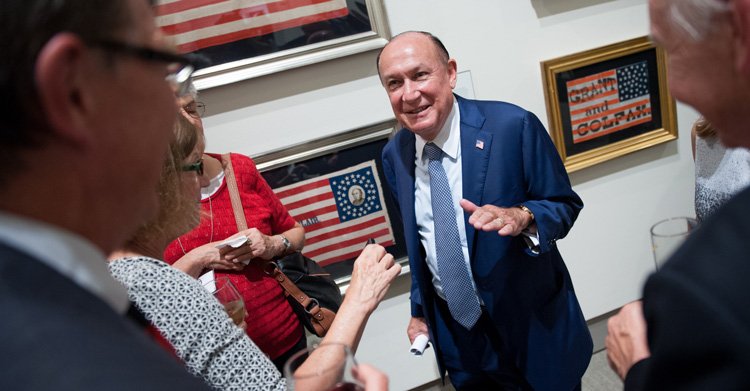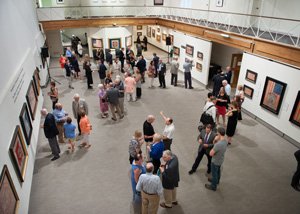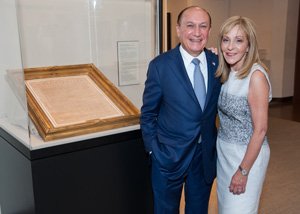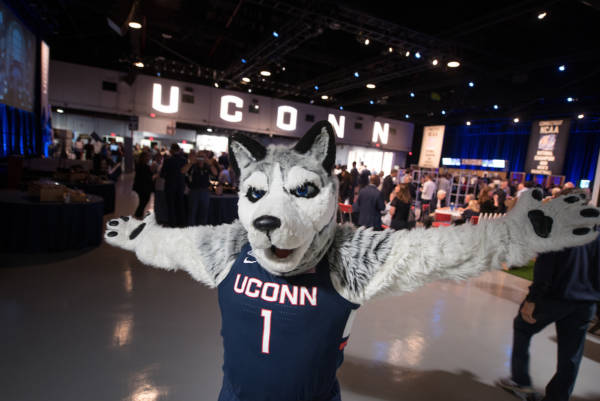UConn Alum Reveals Rare Campaign Flag Collection

The presidential race between Donald Trump and Hillary Clinton has been one of the most contentious and rancorous campaigns in US history. But it is hardly the nastiest.
Just ask Mark Shenkman ’65 (CLAS) H ’07, an American history buff and a pre-eminent collector of American political campaign flags. Shenkman says the race between Henry Clay and James Polk in 1844 was every bit as heated.
“You think today Donald Trump is a disruptive person? Henry Clay needed to re-invent himself as an outsider and populist, just like Donald Trump,” Shenkman said. “The country was changing. Today the issue is immigration, back then it was race and immigration.”
Shenkman’s favorite flag in his collection is from that very election and depicts Clay, a Whig, as a raccoon thumbing his nose at the establishment. The raccoon, a symbol of the Whig party, was the perfect vehicle to lighten his image.
That flag is among the extensive collection of political campaign flags, banners, and kerchiefs that he and his wife Rosalind have loaned to UConn through Dec. 18 for a display at the William Benton Museum of Art.
 The collection, one of the largest public exhibits ever staged of these historic treasures, includes flags from Abraham Lincoln’s two campaigns and a kerchief from the 1840 campaign of William Henry Harrison, who was president for only 30 days before he died of pneumonia.
The collection, one of the largest public exhibits ever staged of these historic treasures, includes flags from Abraham Lincoln’s two campaigns and a kerchief from the 1840 campaign of William Henry Harrison, who was president for only 30 days before he died of pneumonia.
Presidential flags, banners, and kerchiefs were essentially billboards decorated to promote the candidate and his platform during the period of American history from 1840 to 1912. Typically, they were creatively designed American flags decorated with the candidate’s name, ticket, portrait, or campaign slogan to muster support for the candidate.
In the 1800s, the large campaign banners might have been hung from barn walls while the smaller flags would have been affixed to sticks and waved at rallies and conventions.
“Graphically and historically, these are spectacular,” said Jeff Bridgman, a leading expert on antique flags and curator of the exhibit. “Because of all the liberties that people had in flag design, these are some of best examples 19th patriotic American folk art that there are. The kerchiefs and other textiles are absolutely fabulous.”
Shenkman, founder and president of Shenkman Capital Management Inc., began collecting the flags after attending a Sotheby’s auction in 1997, where he was stunned to see a Jasper Johns painting of an American flag sell for $7 million. To Shenkman, the flag painting had none of the historical value or creativity of the historical flags he’d seen bedecked with slogans and unusual patterns.
Three years later, Shenkman went to a sale of antique American flags and bought his first one, a beauty advertising Ulysses S. Grant’s campaign in 1868.
“That got me started. I caught the fever,” Shenkman said.
Shenkman is now believed to have the largest private collection of presidential campaign flags and textiles—about 155 of them—in the United States.
“I have a genuine interest in American history and I like the graphic design, the art, the color, and the history that these flags show,” he said. “Also, I like that it was a small market, a niche in Americana collectibles.”

One of the reasons the flags are so rare is that they were considered rather expendable at the time, he said.
“If the candidate won the election, people then kept them. If their candidate lost, they threw them away. So those are the hardest to collect because they are rare,” he said.
Shenkman was never a big collector when he was a child, though he was partial to baseball cards, especially the Yankees. He traces his passion for Americana and American history to his childhood when his parents would take him on trips to Colonial Williamsburg, Gettysburg, and Washington, D.C.
“I’ve always had a great passion for decorative art and collecting and preserving American art in general,” he said.
In addition to flags, Shenkman collects American paper currency and historical documents. The Benton exhibit include an original broadside of the Declaration of Independence printed in 1776 in Boston.
Shenkman grew up in Pawtucket, R.I. When he was 18, his family moved to West Hartford and his father opened a textile company in Manchester, Conn. He attended Wilbraham & Monson Academy in Wilbraham, then came to UConn, where he majored in political science. He went on to earn an MBA at the George Washington University in 1967.
In 1985, he founded Shenkman Capital Management, a global money management firm headquartered in New York City. He and his wife, Rosalind, a retired social worker, now live in Greenwich, Conn., and have three grown sons—all of whom work at his company—and nine grandchildren.
In addition to loaning his presidential flag collection to UConn, Shenkman has been a generous donor to the University. He has also served on the UConn Foundation’s board of directors for 18 years, including three as chairman, and the boards of trustees at George Washington University and Wilbraham & Monson Academy. His strong belief in education dovetails with his passion for history.
“I feel that education is the cornerstone of a democracy and it all ties in to the idea that you have to have a citizenry that is educated and informed. We’ve got to have educated citizens who know their American history.”
Learn more about the exhibit at the William Benton Museum of Art
